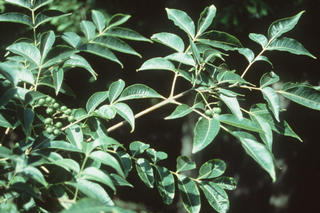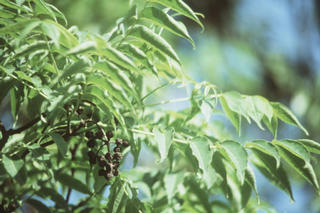Phellodendron chinense
Contents
Nomenclature
Other Names:
Historical Use of Phellodendron chinense
Phellodendron chinense in Traditional Chinese Medicine
Background
Chinese Name (pinyin): Huangbo
Chinese Name :
Common Name :Bark of Chinese Corktree
Specific Name : Cortex phellodendri
Scientific Name:
Collection : The drug is collected, removed from coarse bark and dried in the sun.
Description : Chuan Huangbo, tabular or shallowly channeled, varying in length and width, 3-6mm thick, outer surface yellowish brown, even or longitudinally furrowed, some showing scars of lenticels and remains of greyish coarse bark, inner surface dark yellow or pale brown with fine longitudinal ridges. Texture light and hard, fracture fibrous showing lobelike layes, dark yellow, odour slight, taste very bitter, viscous after chewing.Guan Huangbo: 2-4mm thick, outer surface yellowish green or pale brownish yellow, relatively even with irregular longitudinal fissures, scars of lenticels small and infrequently visible, occasionally remaining greyish-white coarse bark. Inner surface yellow or yellowish brown, texture light and relatively hard, fracture bright yellow or yellowish green.
Identification : 1.Powder: Greenish yellow or yellow, fibres bright yellow, 16-38µm in diameter, often in bundles, sorounded by parenchymatous cells containing prisms of calcium oxalate forming crystal fibres, the walls of crystal cells lignified and thickened. Stone cells bright yellow, subrounded or fusiform, 35-128µm in diameter, some branched sharp at the top, walls thickened with striations distinct. Prisms of calcium oxalate up to 24µm in diameter.2.To 1g of the powder, add 10ml of ether, shake well, filter and evaporate the filtrate to dryness. Dissolve the residue in 1ml of glacial acetic acid, add 1 drop of sulfuric acid and allow to stand, a purplish brown colour is produced..3.Heat under reflux 0.1g of the powder with 5ml of methanol for 15 minutes on a water bath and filter. To the filtrate add methanol to produce a 5ml solution as the test solution of cortex Phellodendri reference drug in the same manner as the reference drug solution. Dissolve berberin hydrochloride CRS in methanol to produced a solution containing 0.5mg per ml as the reference solution. Carry out the method for thin layer chromatography (Appendix Vl B) using silica gel G as the coating substance and benzene-ethylacetate-isopropanol-concentrated ammonia TS (6:3:1:5:0.5) as the mobile phase. Apply separately to the plate 1µl of each of the three solutions. After developing and removal of the plate, dry it in the air and examine under ultra violet light (365nm). The fluorescent spots in the chromatogram obtained with the test solution correspond in position and colour to the spots in the chromatogram obtained with the reference drug solution. The yellow fluorescent spot in the chromatogram obtained with the test solution correspond in the position and colour to the spot in the chromatogram obtained with the reference solution.
Processing : Eliminate foreign matter, spray with water, soften thoroughly, cut into slivers and dry.Processed with salt: Stir fry the slivers as describe under the method of stir frying with salt water (Appendix ll D) to dryness.Carbonized: Stir fry the slivers as describe under the method of carbonizing by stir frying (appendix ll D) until the surface becomes charred black.
Action : To remove damp-heat, quench fire, counteract toxicity, and relieve consumptive fever. Cortex Phellodendri (processed with salt): To nourish yin and reduce fire.
Indication :
Precautions :
Dosage : 3 to 12 g; appropraite quantity for external use.
Storage : Preserve in a ventilated and dry place, protected from moisture.
Synonymns for Phellodendron chinense
Patent Medicines and Medicines with Multiple Ingredients that include Phellodendron chinense
Pharmaceutical Information
Chemical Constituents
Evidence or the Use of Phellodendron chinense in the Treatment of Epilepesy
Basic Science
Animal Studies
Cohort, Case-Control and Non-Randomized Trials
Randomized Controlled Trials
Meta-Analysis
1st Five Results: pubmed search
Bairong Zhang, Jiaxin Liang, Huana Fan, Kaijun Lei, Huaiguo Li, Dongwen Liu, Fanghao Zheng, Mingfeng He, Yanfen Chen
Study on anti-inflammatory effect of Shangkehuangshui in vitro and in vivo based on TLR4/TLR2-NF-κB signaling pathway.
J Ethnopharmacol: 2024, 323;117709
[PubMed:38181931]
[WorldCat.org]
[DOI]
(I p)
Yuanzheng Gu, Xianglin Chen, Yan Shen, Xiaoyong Chen, Gongxiu He, Xinxing He, Guangjun Wang, Hanjie He, Zhencheng Lv
##Title##
Front Microbiol: 2023, 14;1302775
[PubMed:38173676]
[WorldCat.org]
[DOI]
(P e)
Lv Yang, Shengwei Luo, Jing Jiao, Wende Yan, Baiquan Zeng, Hanjie He, Gongxiu He
##Title##
Int J Mol Sci: 2023, 24(22);
[PubMed:38003235]
[WorldCat.org]
[DOI]
(I e)
Ru Wang, Liang-Jun Guan, Liang-Mian Chen, Rui Peng, Jing-Jing Zhu, Xiao-Qian Liu, Hui-Min Gao, Zhi-Min Wang
[Discovery, isolation and structural identification of alkaloid glycosides in six traditional Chinese medicine such as Coptis chinensis].
Zhongguo Zhong Yao Za Zhi: 2023, 48(17);4598-4609
[PubMed:37802799]
[WorldCat.org]
[DOI]
(P p)
Heng Zhu, Yanling Geng, Shangzhi Ding, Enxia Li, Lili Li, Xiao Wang, Jinqian Yu
Separation and purification of alkaloids and phenolic acids from Phellodendron chinense by pH-zone refining and online-storage inner-recycling counter-current chromatography.
J Sep Sci: 2023, 46(22);e2300497
[PubMed:37737621]
[WorldCat.org]
[DOI]
(I p)

